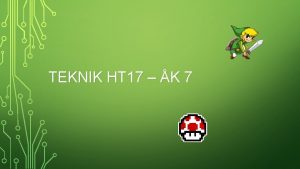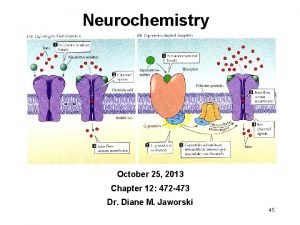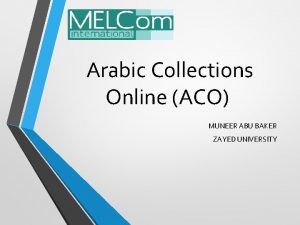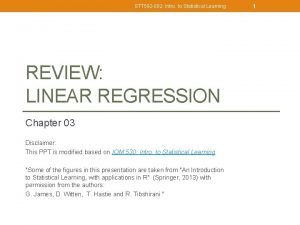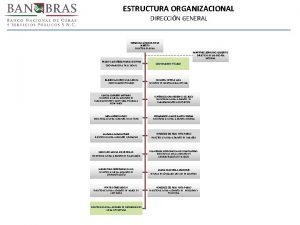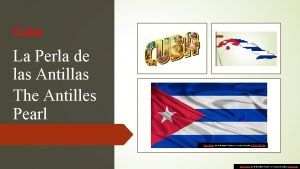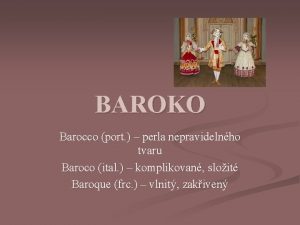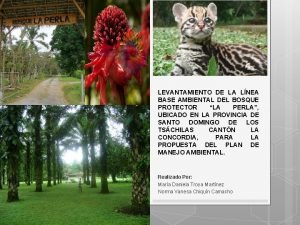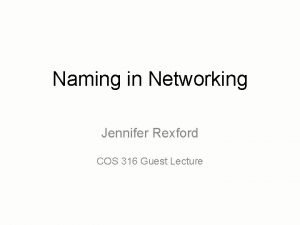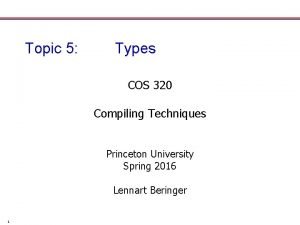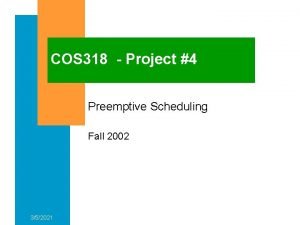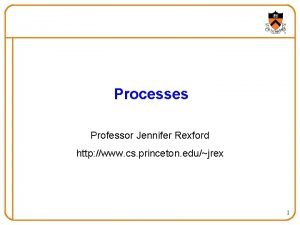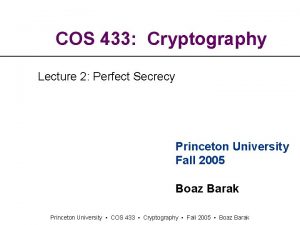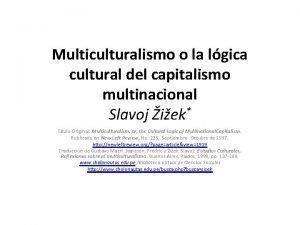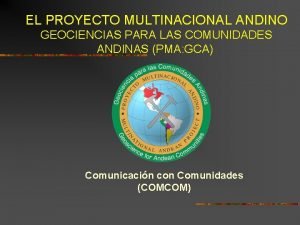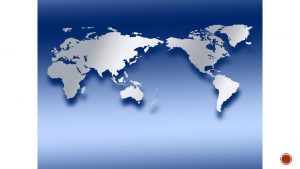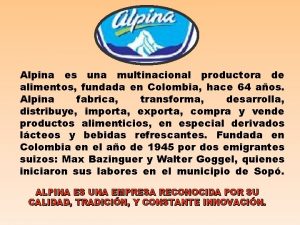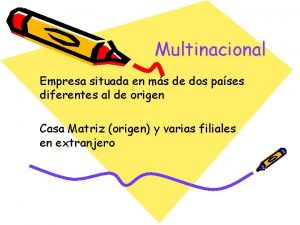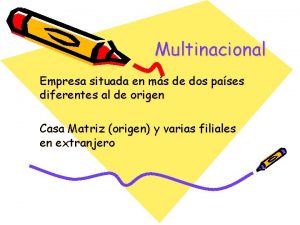http perla princeton edu 2014 PERLA Multinacional con




















































































- Slides: 84

http: //perla. princeton. edu/

2014

PERLA �Multinacional con Colaboradores de Brasil, Colombia, México, Perú y Estados Unidos �Multidisciplinar �Baseados en Encuestas/”Surveys” en 2010 Con Representación Nacional �Dos Estagios: � 1. Modulo Étnico en el Barómetro de las Américas en 8 a 25 Países (LAPOP) � 2. Encuestas en Profundidad en Brasil, Colombia, México y Perú

Temas de las Encuestas Clasificación Etnoracial Desigualdades Etnoraciales Percepciones de Discriminación Opinión Publica Actitudes Raciales Movimientos Sociales Políticas Publicas Engráciales

Preocupaciones �Diversidad de Países con Formaciones Etnoraciales Distintas �Investigar Afro descendientes e Indígenas �Empíricamente Testar Desacuerdos/Dudas en Nuestras Discusiones �Entender Implicaciones de Múltiples Maneras de Clasificación Etnoracial para Conteo Poblacional y Desigualdades

Color Palette

Inconsistencias en la Mediación Etnoracial �Clasificación Etnoracial en los Censos e en Encuestas es Medida de Varias Maneras y depende de la pregunta y las categorías usadas y quien responde


Ejemplos de Preguntas de Censos y Categorias de Respuestas � Preguntas: � Su Color o Raza es…. ? (Brasil) � Como Ud. Se Considera…? (Ecuador) � A que grupo etnico (pueblo) pertenece? (Guatemala) � Segun su cultura, pueblo or razgos fisicos, Ud. es o se considera? …. (Colombia) � Ud. Pertenence a la…. Cultura? (Costa Rica) � Ud. O Alguno de sus antepasados es…? (Uruguay, Argentina) � Cual es su color de Piel? (Cuba) � Categorias de Respuesta: � Para indigenas, indigena o grupo etnico o idioma hablado � Para Afrodescendientes: negro, mulato, pardo afrodescendiente, Afro-(Pais), , preto, raizal, moreno? Indio?

1. La Mediación de Raza tiene Implicaciones para La Proporción Indígena y Afro descendiente

Indígenas en México

ed to /P re ar do do do ar /P et o Pr pa r r 6+ ha i or o ir ha ar d rly d ie tif : P er w ie rv ifi C ol /c u in : P ed y nk or st o pr et an ce Ki ky in Sk id en lfen t id In te 8_ _x 00 1 lf- & nen d 6+ an ric 10 _K _S e 15 Se b_ _x 00 1 00 _x or pe _O 01 1 _x 0 ol C 15 _ d ie 50 Af tif re to �Figure 00 10 _ 00 en : P p ro N eg 60 _x _x id el f- d: ed nen d pe 15 _S 00 _x en de n- pe O _O 01 1 _x 0 11 _ 00 _x Quantos Negros no Brasil? 5. 2 40 30 20 10 0

¿Cuántos indígenas en Perú? : depende…

Comparación entre Peru y Mexico y Entre Pueblos Indigenas Peru: Quechua & Aymara 100, 00% 90, 00% 80, 00% 70, 00% 60, 00% 50, 00% 40, 00% 30, 00% 20, 00% 10, 00% Mexico: 4 Pueblos Indigenas 100 90 80 70 60 50 40 30 20 10 0 Se considera indigena* Habla idioma Quechua Aymara Cualquiera de los padres Se considera indigena* Nahuatl Habla idioma Maya Zapoteco Cualquiera de los padres es X Mixteco

2. La Desigualdad Medida Por Categorías Etnoraciales de Tipo Censos son Inconsistentes e a veces, No Como Esperado Indígenas Consistentemente los en maior Desventaja b. Mestizos Están en mejor Situación que Blancos a.

Educational attainment and Identity 12 Non-Indig 11 10 Non-Indig, non-Afro Indig 9 Non-indig Indig 8 7 6 Indig 5 4 Bolivia Guatemala Non-indigenous Mexico Indigenous Colombia Afro

Educational attainment and Identity White 12 Mestizo Mulato 11 Indig Mestizo White 10 Afro White 9 White Pardo 8 Preto Negro Indig Indio 7 6 5 4 Brazil DR Afro Ecuador

3. La Desigualdad Por Color de Piel es Mas Consistente y en la Dirección Esperada

Educational Attainment 12 10 8 6 4 2 0 Mexico Peru Light Colombia Medium Brazil Dark Skin Color Ecuador

Household Income 6 5 4 3 2 1 0 Mexico Peru Light Colombia Medium Brazil Dark Skin Color Ecuador

Top Household Income 30 25 20 15 10 5 0 Mexico Peru Light Colombia Medium Skin Color Brazil Dark Ecuador

Bottom Household Income 30 25 20 15 10 5 0 Mexico Peru Light Colombia Medium Skin Color Brazil Dark Ecuador

Educational Attainment 12 10 8 6 4 2 0 Mexico Peru Light Colombia Medium Brazil Dark Skin Color Ecuador

Household Income 6 5 4 3 2 1 0 Mexico Peru Light Colombia Medium Brazil Dark Skin Color Ecuador

Top Household Income 30 25 20 15 10 5 0 Mexico Peru Light Colombia Medium Skin Color Brazil Dark Ecuador

Bottom Household Income 30 25 20 15 10 5 0 Mexico Peru Light Colombia Medium Skin Color Brazil Dark Ecuador

Skin color and educational attainment Mean Years of Education Central America and Mexico 13 12 Panama Costa Rica Honduras Mexico Guatemala El Salvador Nicaragua 11 10 9 8 7 6 5 Respondent color

Skin color and educational attainment Mean Years of Education Andean 13 12 11 Bolivia Peru Venezuela Colombia Ecuador 10 9 8 7 6 5 Respondent color

Skin color and educational attainment Southern Cone and Brazil Mean Years of Education 13 12 11 Argentina Chile Paraguay Uruguay Brazil 10 9 8 7 6 5 Respondent color

Skin color and educational attainment Mean Years of Education Caribbean 13 12 11 10 Suriname 9 Jamaica 8 7 Trinidad & Tobago 6 5 Respondent color

� 4. La Discriminación Racial/Por Color es Altamente Percibido Contra Si y Contra Otros en los Cuatro Países � 5. La Mayoría de el Publico Apoya Movimientos Sociales Engráciales y Políticas Publicas que promueven gente afro-descendiente y indígena



Primary Ethnoracial Question in America’s Barometer �In most countries, Do you consider yourself white, mestizo, indigenous, black, mulatto or other? �In Spanish, Usted se considera una persona blanca, mestiza, indigena, negra, mulata u otra? �In Portuguese, Vôce se considera uma pessoa branca, parda, preta, indigena, ou amarela?

Auto Iden. Racial Self. Identification is Loosely Related to Actual Skin Color

Ethnic identity and skin color, (1=Lightest, 11=Darkest) Bolivia Brazil 40 35 30 25 20 15 10 5 0 1 2 3 4 5 6 7 Indigenous 8 9 10 11 1 2 Non-Indigenous 3 4 White Colombia 5 6 7 Indigenous 8 9 Pardo 10 11 Preto Dominican Republic 40 35 30 25 20 15 10 5 0 1 2 3 4 5 Indigenous 6 7 Afro 8 9 None 10 11 1 2 3 4 5 6 Black 7 8 9 10 11

Ethnic identity and skin color, (1=Lightest, 11=Darkest) Ecuador Guatemala 45 40 35 30 25 20 15 10 5 0 1 2 3 White 4 5 6 7 Mestizo 8 9 10 Indigenous 11 1 2 3 Afro 4 5 6 7 Indigenous Mexico 8 9 10 11 Non-Indigenous Peru 45 40 35 30 25 20 15 10 5 0 1 2 3 4 5 Indigenous 6 7 8 9 Non-Indigenous 10 11 1 2 White 3 4 5 Mestizo 6 7 Indigenous 8 9 Black/Mulatto

La Desigualdad Medida Por Categoría Tipo Censos son Inconsistentes e a veces, No Como Esperado Indígenas Consistentemente los mas en Desventaja b. Mestizos Están en mejor Situación que Blancos a.

Educational attainment and Identity 12 Non-Indig 11 10 Non-Indig, non-Afro Indig 9 Non-indig Indig 8 7 6 Indig 5 4 Bolivia Guatemala Non-indigenous Mexico Indigenous Colombia Afro

Educational attainment and Identity White 12 Mestizo Mulato 11 Indig Mestizo White 10 Afro White 9 White Pardo 8 Preto Negro Indig Indio 7 6 5 4 Brazil DR Afro Ecuador

La Desigualdad Por Color de Piel es Mas Consistente y en la Dirección Esperada

Skin Color and Educational Attainment 12 11 10 9 8 7 6 5 Medium Dark Pe ru ex ic o m te ua G Light M al a r Ec ua do R D bi a ol om C Br az il Bo liv ia 4




6. Race is Sui Generis throughout Latin America �Ethnoracial Inequality is Independent of Class/Socioeconomic Origins

Table for 23 Countries

National Differences in the Effect of Skin Color on Educational Attainment

7. Latin Americans Recognize Discrimination against Blacks and Indgenous �For Dominants, Certainly More than the United States �Except Bolivia

8. Perceived Discrimination Latin Americans often perceived discrimination by race, language or color and black, indigennous and dark skin persons report that they have been discriminated on those factors

Recent Publications � � � � � Flores, René and Edward Telles. 2012. “Social Stratification in Mexico: Disentangling Color, Ethnicity and Class. ” American Sociological Review 77(3): 486 -494 Telles, Edward and Liza Steele. 2012. “Pigmentocracy in the Americas: How is Educational Attainment Related to Skin Color? Insights 73 Telles, Edward and Denia Garcia. 2013. “Mestizaje and Public Opinion in Latin America” Latin American Research Review 48(3): October, 130 -152 Telles, Edward and Stan Bailey. 2013. “Understanding Latin American Beliefs about Racial Inequality” American Journal of Sociology 118(5): August, 1559 -1595 Telles, Edward E. and René Flores. 2013. “More than Just Color: Whiteness, Nation and Status in Latin America” Hispanic American Historical Review 93(3): March, 411 -449 Telles, Edward and Tianna Paschel. 2014. Beyond Whitening: Color, Status and Nation in Latin Amerian Racial Classification” American Journal of Sociology Pereira, Krista and Edward Telles. 2014. “Color, Racial Classification and Discrimination in the Health of Latin Americans” Social Science and Medicine Telles, Edward E. and the Project on Ethnicity and Race in Latin America. 2014. Pigmentocracies: Ethnicity, Race and Color in Latin America. Chapel Hill: University of North Carolina Press Telles, Edward, René Flores and Fernando Urrea Giraldo, “Pigmentocracies: Skin Color, Census Ethnoracial Categories and Educational Inequality in

FIN/FI/FIM/END

Various Census Questions and Categories: Mostly Self Identification � Questions: � Your color or race is…? (Brazil) � How do you consider yourself…? � To what ethnic group (people) do (Ecuador) you belong? (Guatemala) � According to your culture, people or physical features, are you or do you consider yourself…(Colombia) � Do you belong to the … culture? (Costa Rica) � In countries Venezuela and Paraguay, separate questions for afro-descendants and indigenous � Response categories: � For indigenous, indigena or as a particular ethnic group or language. Early Censuses used attire, diet or community

Ethnoracial Inequality

Educational Attainment 12 10 8 6 4 2 0 Brazil White Mexico Mestizo Colombia Indigenous Identity Ecuador Mulatto/Pardo Peru Black

Household Income 6 5 4 3 2 1 0 Brazil White Mexico Mestizo Colombia Indigenous Ecuador Peru Mulatto/Pardo Black Identity

Top Household Income 25 20 15 10 5 0 Mexico White Peru Mestizo Colombia Indigenous Identity Brazil Ecuador Mulatto/Pardo Black

Bottom Household Income 30 25 20 15 10 5 0 Mexico White Peru Mestizo Colombia Indigenous Identity Brazil Ecuador Mulatto/Pardo Black

Educational Attainment 12 10 8 6 4 2 0 Brazil White Mexico Mestizo Colombia Indigenous Identity Ecuador Mulatto/Pardo Peru Black

Household Income 6 5 4 3 2 1 0 Brazil White Mexico Mestizo Colombia Indigenous Ecuador Peru Mulatto/Pardo Black Identity

Top Household Income 25 20 15 10 5 0 Mexico White Peru Mestizo Colombia Indigenous Identity Brazil Ecuador Mulatto/Pardo Black

Bottom Household Income 30 25 20 15 10 5 0 Mexico White Peru Mestizo Colombia Indigenous Identity Brazil Ecuador Mulatto/Pardo Black

Pigmentocracy �(not picked up in ethnoracial census categories)

Color Palette

Take Away Points �Skin Color (External Identification) Matters �Skin Color Matters particularly in Some Countries �Ethnoracial Identification (Self. Identification) may be Less Important than Color �Ethnoracial Identification and Skin Color do not necessarily Overlap �Class Origins Also Matter �This is Work in Progress

�Importance of Race Mixture (Mestizaje) in Latin America (vs Segregation in the United States) � 1. mixture facilitated by demographic imbalance between colonizers and colonized � 2. nationalizing elites made mixture central to national identity � 3. little history of racial segregation (some in PR, Cuba and Panama) � 4. often use mixed race categories � 5. classification is more fluid and ambiguous � 6. a national ideology of mixture widely accepted and downplays or denies importance of race and racial disadvantages AND THIS HAS AFFECTED RESEARCH ON THE TOPIC

OLS MODELS PREDICTING SES IN ECUADOR � Note: Controls for Sex, Age, Community size, and geographical region. Household Income model also controls for education, age 2, and PERLA/LAPOP survey.

OLS Models predicting SES in Brazil � Note: Controls for Sex, Age, Community size, and geographical region. Household Income model also controls for education, age 2, and PERLA/LAPOP survey.

OLS Models predicting SES in Mexico � Note: Controls for Sex, Age, Community size, and geographical region. Household Income model also controls for education, age 2, and PERLA/LAPOP survey.

OLS Models predicting SES in Colombia � Note: Controls for Sex, Age, Community size, and geographical region. Household Income model also controls for education, age 2, and PERLA/LAPOP survey.

OLS Models predicting SES in Peru � Note: Controls for Sex, Age, Community size, and geographical region. Household Income model also controls for education, age 2, and PERLA/LAPOP survey.

Brazil Colombia 45 40 35 30 25 20 15 10 5 0 1 2 3 4 5 6 7 8 9 10 11 1 2 3 4 Ecuador 5 6 7 8 9 10 11 Mexico Peru 45 40 35 30 25 20 15 10 5 0 1 2 3 4 5 6 White 7 8 9 10 11 Mestizo 1 2 3 4 5 6 7 8 Indigenous 9 10 11 1 Mulatto 2 3 4 5 6 Black 7 8 9 10 11

Brazil

Mexico

Colombia

Ecuador

Peru

dr e Pa o el > Pi ad re M =6 + lo ab el C 6 >= el Pi o sp re C po es cr ro or N eg do / el lo ab C ar /P re to st ad vi nt re -e ad en tid o an ad tid ric Af id o- o ad ut -A do ar -P o/ P et do ar /P et o Pr Pr as te p An rta ie ab id en o- ut -A a nt gu -p re et o Pr fro /A ro N eg % of respondents 70, 00 Brasil: Porcentaje de entrevistados clasificados como negros o con antepasados negros, por diferentes indicadores 60, 00 50, 00 40, 00 30, 00 20, 00 10, 00

Colombia: Porcentaje de entrevistados clasificados como negros o con antepasados negros, por diferentes indicadores 70, 00 60, 00 % of respondents 50, 00 40, 00 30, 00 20, 00 10, 00 Negro/Afro - Negro - auto- Antepasado Negro/Mulato Padre o Piel>=6 + pregunta identidad Africano - auto. Madre. Cabello abierta identidad entrevistador. Negro/Mulato Crespo Cabello Crespo, rizado Piel>=6

México: Porcentaje de entrevistados clasificados como indigenas o con antepasados indigenas, por diferentes indicadores 50, 0 45, 0 40, 0 % of respondents 35, 0 30, 0 25, 0 20, 0 15, 0 10, 0 5, 0 do ep a sa re ua lq ui er an t ui er pa d dr e Pa C ua lq C Am bo s M ad re s br e tu m os /C ne s Tr ad ic io Le pa dr e s a er n at M ng u a ab ie rta un ta or Pr eg es ta d En cu Se co ns id er a 0, 0

Dominant Group White Mestizo Mulatto Mestizaje Indigenous Black

50, 0 Perú: Porcentaje de entrevistados clasificados como indigenas o con antepasados indigenas, por diferentes indicadores 45, 0 40, 0 % of respondents 35, 0 30, 0 25, 0 20, 0 15, 0 10, 0 5, 0 do re C ua lq C ui er ua lq an t ep a sa ui er pa d e Pa dr re ad M dr es Am bo s tu m os /C ne s Tr ad ic io Le pa br e s a er n at M ng u a ab ie rta un ta or Pr eg es ta d En cu Se co ns id er a 0, 0

6 el >= Pi + lo be l ca llo be dr e pa ca 1+ o 6 ad o >= el Pi riz po / /ri z po es es cr cr at an o /M ul ric Af ro eg N ro st or D -I ad st ue nc -e An ce o at rta ie ab ie rta Ab at o ul /M ro eg N a nt gu ta r a er id ns co eg un -p re /M ul ro eg N at o ul eg ro /M N Pr Se do ta es cu En % of respondents Perú: Porcentaje de entrevistados clasificados como negros/mulatos, por diferentes indicadores 25, 00% 20, 00% 15, 00% 10, 00% 5, 00% 0, 00%

Peru: Quechua & Aymara 100, 00% 90, 00% 80, 00% 70, 00% 60, 00% 50, 00% 40, 00% 30, 00% 20, 00% 10, 00% Mexico: Grupos Indigenas 100 90 80 70 60 50 40 30 20 10 0 Se considera indigena* Habla idioma Quechua Aymara Cualquiera de los padres Se considera indigena* Nahuatl Habla idioma Maya Zapoteco Cualquiera de los padres es X Mixteco
 Cs.princeton.edu
Cs.princeton.edu El sr. figueres es ____. actor hombre de negocios pintor
El sr. figueres es ____. actor hombre de negocios pintor Bunge empresa multinacional
Bunge empresa multinacional Edu.sharif.edu
Edu.sharif.edu Htttps://scratch.mit.edu/
Htttps://scratch.mit.edu/ Teachertech.rice.edu
Teachertech.rice.edu Https.//scratch.mit.edu
Https.//scratch.mit.edu Https scratch mit edu download
Https scratch mit edu download Https://scratch
Https://scratch Https://scratch.mit.edu
Https://scratch.mit.edu Numericalmethods.eng.usf.edu
Numericalmethods.eng.usf.edu Http://learn.genetics.utah.edu/content/addiction/
Http://learn.genetics.utah.edu/content/addiction/ Http://learn.genetics.utah.edu/content/addiction/
Http://learn.genetics.utah.edu/content/addiction/ Administration.assessform
Administration.assessform Space shuttle discovery
Space shuttle discovery Http:scratch.mit.edu
Http:scratch.mit.edu Http://learn.genetics.utah.edu/
Http://learn.genetics.utah.edu/ Sir isaac newton
Sir isaac newton Egif umich
Egif umich Single slit envelope
Single slit envelope Http://numericalmethods.eng.usf.edu
Http://numericalmethods.eng.usf.edu Wave optics topics
Wave optics topics Http://scratch.mit.edu
Http://scratch.mit.edu Dendro.cnre.vt.edu photosynthesis chloroplast
Dendro.cnre.vt.edu photosynthesis chloroplast Gestalt leveling
Gestalt leveling Evolution berkeley
Evolution berkeley Http://weather.uwyo.edu/upperair/sounding.html
Http://weather.uwyo.edu/upperair/sounding.html Http://weather.uwyo.edu/upperair/sounding.html
Http://weather.uwyo.edu/upperair/sounding.html Http://dlib.nyu.edu/aco/
Http://dlib.nyu.edu/aco/ Http sinhvien hufi
Http sinhvien hufi Http://www.colorado.edu/physics/phet
Http://www.colorado.edu/physics/phet Http corpus byu edu coca
Http corpus byu edu coca Reshuege math
Reshuege math Faculty marshall usc advertising csv
Faculty marshall usc advertising csv What monomers make up protein
What monomers make up protein Naplan locked down browser
Naplan locked down browser Http://numericalmethods.eng.usf.edu
Http://numericalmethods.eng.usf.edu 2learner
2learner Tin yu
Tin yu Http //mbs.meb.gov.tr/ http //www.alantercihleri.com
Http //mbs.meb.gov.tr/ http //www.alantercihleri.com Http //pelatihan tik.ung.ac.id
Http //pelatihan tik.ung.ac.id Carola manzanares
Carola manzanares Lucina jiménez
Lucina jiménez Pupille perla
Pupille perla Perla de las antillas
Perla de las antillas Perla barocco
Perla barocco Perla barocco
Perla barocco Ostras perlas dolor
Ostras perlas dolor Baroko perla
Baroko perla El reino de dios es como una perla
El reino de dios es como una perla Lorena perla alta
Lorena perla alta Caracteristicas de la musica en el periodo barroco
Caracteristicas de la musica en el periodo barroco Barocco perla
Barocco perla Chiu pascoli
Chiu pascoli Perla britskej koruny
Perla britskej koruny Ubicacion geografica
Ubicacion geografica Pics princeton
Pics princeton Cos 316 princeton
Cos 316 princeton Iac princeton
Iac princeton Hantao ji princeton
Hantao ji princeton Cos 423
Cos 423 Cos 423
Cos 423 Cos 217
Cos 217 Princeton cos
Princeton cos Quasicrystals ppt
Quasicrystals ppt Eric larson princeton
Eric larson princeton Roberto car princeton
Roberto car princeton Princeton policy task force
Princeton policy task force Princeton university’s gerrymandering project
Princeton university’s gerrymandering project Cos 318 princeton
Cos 318 princeton Citp princeton
Citp princeton The china market research group
The china market research group Emil praun
Emil praun Kirk mcdonald physics
Kirk mcdonald physics Cos 318 princeton
Cos 318 princeton Tigerpay princeton
Tigerpay princeton Wwwcs princeton
Wwwcs princeton Business headshots princeton
Business headshots princeton Princeton matlab
Princeton matlab Chris tully princeton
Chris tully princeton Princeton cos
Princeton cos David spergel princeton
David spergel princeton Avi wigderson princeton
Avi wigderson princeton Princeton cos certificate
Princeton cos certificate Princeton
Princeton




